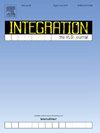Ultra-low power linearized FVF based BD double diffusor double differential pair transconductor
IF 2.2
3区 工程技术
Q3 COMPUTER SCIENCE, HARDWARE & ARCHITECTURE
引用次数: 0
Abstract
The demand for low-power transconductors capable of delivering linear performance is rising especially in biomedical applications. This work introduces a flipped voltage follower (FVF)-based bulk-driven (BD) double diffusor double differential pair (D4P) transconductor designed using 0.18 μm technology. The proposed design operates effectively at ±0.5 V, achieving a linear range of 0.2 V, transconductance (Gm) of 1.07 μS, power dissipation of 0.365 μW, gain of 27 dB, a gain-bandwidth product of 27 kHz. Further analysis reveal the figure of merits, FOM1 and FOM2 values of proposed transconductor are 240 and 29.38, respectively with a linearity enhancement factor of 1.7 which are quite encouraging. Monte Carlo analysis show the Gm, gain and total harmonic distortion have mean values of 1.06 μS, 26.13 dB, −47.40 dB, respectively which are close to their nominal values. The total layout area of the transconductor is 20204.54 μm2, providing a compact yet effective design for low-voltage applications.
求助全文
约1分钟内获得全文
求助全文
来源期刊

Integration-The Vlsi Journal
工程技术-工程:电子与电气
CiteScore
3.80
自引率
5.30%
发文量
107
审稿时长
6 months
期刊介绍:
Integration''s aim is to cover every aspect of the VLSI area, with an emphasis on cross-fertilization between various fields of science, and the design, verification, test and applications of integrated circuits and systems, as well as closely related topics in process and device technologies. Individual issues will feature peer-reviewed tutorials and articles as well as reviews of recent publications. The intended coverage of the journal can be assessed by examining the following (non-exclusive) list of topics:
Specification methods and languages; Analog/Digital Integrated Circuits and Systems; VLSI architectures; Algorithms, methods and tools for modeling, simulation, synthesis and verification of integrated circuits and systems of any complexity; Embedded systems; High-level synthesis for VLSI systems; Logic synthesis and finite automata; Testing, design-for-test and test generation algorithms; Physical design; Formal verification; Algorithms implemented in VLSI systems; Systems engineering; Heterogeneous systems.
 求助内容:
求助内容: 应助结果提醒方式:
应助结果提醒方式:


